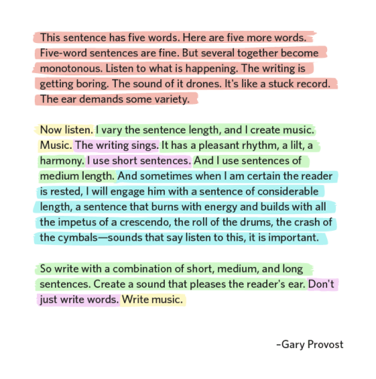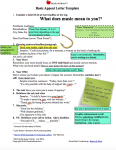No one sets out to write crap.
But when you’re only six weeks into your new fundraising job and your boss suddenly assigns you the task of writing your organization’s year-end fundraising appeal, due tomorrow, what the heck are you going do?
Instead of copying and pasting last year’s letter, how about you carve out some time to create your very own masterpiece? The results will be worth it. I promise.
But how do you do it? Especially with limited time? First off, turn off your phone and the online noise so that you can focus. And then pay heed to these 13 tips and free downloads.
1. Know your audience
My grandmother raised nine children on a dairy farm that lacked the benefit of indoor plumbing. Life was not easy, but her faith got her through the tough times. Years after her children were grown and her  husband was gone, she sold the 250-acre farm. And when she did, nothing made her happier than to present a check for $10,000 to the local Catholic parish.
husband was gone, she sold the 250-acre farm. And when she did, nothing made her happier than to present a check for $10,000 to the local Catholic parish.
It’s easy for me to write for Catholic charities. That’s because I always have my grandmother’s picture in my mind’s eye…
Who is your donor and what are their reasons for giving — what I refer to as their BIG WHY?
Creating a donor profile is one of the most enlightening things you’ll ever do — and it’s my first step in writing a fundraising appeal.
When you can clearly envision the individual you’re writing to, you’ll find your overall communication, from your appeals, to your emails, to your website copy, will take on a deeper, more personal approach. It’ll flow more naturally, too. This is not the type of wealth screening “donor profile” you may be thinking of, but rather what some marketers refer to as a “persona.” Personas have gotten a bad rap lately, thanks to the consultants who don’t understand their purpose. But trust me when I tell you that they have one, and it’s invaluable.
As used in the Simple Development Systems method, personas are first and foremost a tool to help you with your writing. You’ll write better when you know who you’re writing to. Know your audience. It’s the best place to begin.
2. Find your best story
Statistics never sell, but great stories do. What stories resonate the most with your supporters? Believe it or not, data is a useful tool for figuring this out. Let your data inform you on which of your stories are standouts. Which past appeals have raised the most? What do your Facebook analytics tell you about which stories have garnered the highest response rates? What stories have your donors shared?
3. Let emotion rule
When you’re developing the story for your fundraising appeals, consider the words of renowned copywriter Indra Sinha:
”Don’t start by writing. Start by feeling. Feel, and feel passionately, and the emotion you feel will come through the spaces in between the words.“
Above all else, embrace the emotion. You may not feel comfortable writing “that way.” But nothing plays a more effective role in fundraising quite like emotionally compelling storytelling does. Storytelling delights, it inspires, it captures the imagination and, most importantly, storytelling compels donors from all demographics to give. But it can only do that if the emotion is there.
4. Write music
At their optimum potential, your words have the power to resonate and generate an emotional impact. Words can stay with us long after we’ve first read them or heard them, and they’re no longer “just words.” They take on more power. But it is easy to fall into a rut when it comes to writing. The results of this are often dull writing that’s incapable of fully accomplishing what you want it to. So whether you’re writing a book, a short story, or fundraising copy, what American author and writing teacher Gary Provost demonstrates in this simple graphic is worth reading. And remembering. Variety isn’t just the spice of life. It’s critical to your writing!

5. Infuse your letter with gratitude
How are you making your donor feel as she reads your letter? According to researcher Jen Shang, “The good feeling of ‘thank you’ lasts for 2.5 months.” Just two words. They are vital, and their possibilities are endless…
“Thank you for being the power behind this work.” (Donor Love 20 Ways)
“Thank you for helping to build the EmbraceRace community. Thank you for
your support. And thank you for truly being the power behind this work.”
Speaking to your donor directly is a way to impact them and making them feel something, and the gratitude that you convey will have the power to go further and generate more impact. It goes back to emotion, and it goes back to keeping it personal. Without gratitude, consider yourself up a creek without a paddle. And a lifejacket.
6. Put your donor in the picture
Where are your donors in all of this? Your donor is the hero here, so don’t communicate as “we” and make it all about you. It’s not about you. It’s about the amazing supporters who make your work possible. What have they accomplished through their gift? What are they accomplishing through you? Do you communicate this with clarity and effectiveness, while making it warm and personal? Again, it’s about the audience and who you’re talking to. Mention them by their name, and use “you” when you’re speaking to them so that you’re speaking to them directly. And personally.
“Without you, we could never have achieved so much. ”
“When she arrived at the front desk, you were there with a welcoming smile.”
7. Ask
Every year, I receive hundreds of appeal letters from charities of all sizes. And one of the major flaws of the *small shop* letters is that they never get around to actually asking for support. They tread lightly as if they’re walking on eggshells. Right around the last sentence, they might reference a vague “your support.”
As I’m reading your letter, make sure you tell me exactly what you want me to do.
You need funding. You’re giving your donors an opportunity, so ask with clear intention. Be sure to ask early and ask often throughout your letter.
8. “How long should my letter be?”
I get asked this question a lot. In fact, it’s one of the most frequently asked questions I hear when it comes to discussing the nonprofit fundraising letter. And the answer is always this: As long as it takes for you to make a compelling case for support. Your letter should be long enough to make your case. You’ll find no end of studies indicating that longer letters outperform shorter letters, but in reality, longer isn’t always better. It’s about what works best for your unique organization. So while there really is no hard and fast rule, there is one exception: Rarely if ever can your case be presented in one page. Particularly when you create a letter designed to induce reading (14 pt font, plenty of white space). Compelling cases need some space.
9. One writer
Too many cooks spoil the broth, and when it comes to writing your fundraising appeal, this couldn’t be truer. Multiple writers is bound to result in a bit of chaos, and that’s not what you want. The worst fundraising appeals I’ve encountered are those drafted by a committee. Your appeal demands the skills of one writer-storyteller, and the focus should be singular, dedicated, and clear.
10. Outline it
 Maybe you’re a regular writer and you’re already well into the swing of things. You may write so often that when you sit down to write a fundraising letter, the words just flow. But there’s also a good chance that is not the case. Outlines are a valuable tool for getting you started. A standard outline will help to keep you focused on what you want your letter to accomplish, from beginning to end. The Fundraising Appeal Template to the rescue! Add it to your arsenal of fundraising tools. You’ll be glad you did.
Maybe you’re a regular writer and you’re already well into the swing of things. You may write so often that when you sit down to write a fundraising letter, the words just flow. But there’s also a good chance that is not the case. Outlines are a valuable tool for getting you started. A standard outline will help to keep you focused on what you want your letter to accomplish, from beginning to end. The Fundraising Appeal Template to the rescue! Add it to your arsenal of fundraising tools. You’ll be glad you did.
11. Swipe
I once knew a nonprofit founder who made it a regular practice to save direct mail that landed in her mailbox. She was able to recognize what worked in direct mail and what didn’t, and so she held onto the most compelling pieces. She created her own swipe file and filled it with examples, which she used as tools. Over time, she built an enviable donor database and a million-dollar agency simply by emulating what moved her. And to think, it all began by identifying what she felt resonated the most.
I try to regularly spotlight what moves me in direct mail, and you can find a lot of these pieces published as examples on this blog. I probably don’t need to tell you this, but I will anyway: they are examples. Building a swipe file is one thing. Plagiarism is another.
12. KISS
Keep it simple, sweetheart.
“The key to good description begins with clear seeing and ends with clear writing, the kind of writing that employs fresh images and simple vocabulary.”
-Stephen King
Ahhhh, wise words from a master who not only makes it a point to write every day, but writes to be read. Stephen King writes a lot, knows his audience, and produces content that is easily accessible to them. Write at a fifth grade (and below) reading level. It’s not about dumbing down. It’s about talking to people like they’re people. Think about it. How do you speak to people in everyday conversation? You want to bring your readers in and talk to them, not alienate them. Let the Hemingway App guide you.
13. Write drunk. Edit sober.
No, not literally. (But hey, if you want to, I’m not going to try and stop you.) If you’re suffering from the dreaded writer’s block, relax. Put on some music. Dance. Go for a walk. Meditate. Eat a snack. And then sit down, make yourself comfortable, and just…write. Let it go and let it flow. It’ll come naturally if you don’t restrain yourself. Though, to make this exercise most useful, put a time cap on it. And before you start, turn off your phone and get rid of any other distractions. The timer will ding before you know it, and by the end, you’ll have something that you can work with.”
In art, an underpainting is an initial layer of paint applied to a ground, which serves as a base for subsequent layers of paint. Underpaintings are often monochromatic and help to define color values for later painting.” (Wikipedia) Think of your letter as a painting and the first draft as the underpainting.
Stephen King also noted that “The scariest moment is always just before you start. After that, things can only get better.” Boot up your laptop, sit down, and get started!
Tools
Hemingway App: Get your readability score with the Hemingway app. Aim for a fifth-grade reading level and below.
Related Words: This tool helps you find words that are related to a specific word or phrase.
Free Text to Speech: Remember you’re writing to a friend. Does your letter sound natural? Read it out loud or use a tool like Naturalreaders.com
Downloads
Donor Persona Worksheet: Who are you writing TO? Download your Persona Worksheet and get a picture of your reader in your mind’s eye.
Appeal Letter Template: The original Appeal Letter Template will guide you with a solid outline to start.
Books and Resources
How to Write Successful Fundraising Letters (Mal Warwick). This oldie but goodie has scads of examples and swipeable asks, closes, and PS’s.
The Fundraiser’s Guide to Irresistible Communications. (Jeff Brooks)
How to Write Fundraising Materials That Raise More Money: The Art, the Science, the Secrets (Tom Ahern)
SOFII. Sofii.org is a fundraiser’s treasure chest. And the Huntsinger tutorials cannot be beaten.
Direct Mail Masterclass: Going beyond writing your letter, Direct Mail Masterclass | Basics & More™ includes tips on production (particularly if yours is a small nonprofit), design for readability (including the response device), working with vendors, segmentation, and more. Students have doubled and tripled the results of their appeal.

















 I can’t wait to meet with you personally.
I can’t wait to meet with you personally.
Comments on this entry are closed.